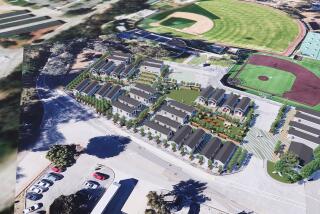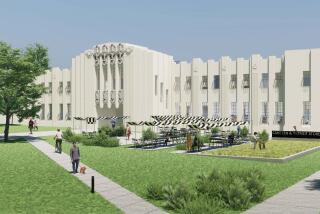Land Donorsâ Families Cite Deed in Saying Sale Would Allow Them to Regain Veterans Administration Site : Pioneersâ Heirs Stake Claim on Westwood Parcel
Descendants of two pioneer families who donated much of the land that makes up the Veterans Administration complex near Westwood hope to regain a 2.13-acre slice of the valuable real estate if the government sells it.
At stake is a bequest of two colorful figures of 19th-Century Southern California: Arcadia Bandini Stearns de Baker, daughter of a leading family during Mexican rule and wife of two of the richest American settlers; and U.S. Sen. John Percival Jones, a gold miner who struck it rich in silver, founded the city of Santa Monica and lived there while representing Nevada in the nationâs capital for 30 years.
Interest in the Jones-de Baker legacy is more than historic, however. The deficit-plagued federal government hopes to sell the land for at least $7.5 million in an auction scheduled for March 27.
The heirs have a hired a lawyer to investigate their claim that the land should revert to them because the VA no longer needs it.
Legal Action Threatened
And Los Angeles County Supervisor Ed Edelman has threatened legal action to block the sale. He argued that the land would be better used for parking or senior citizen housing.
âWe donât need another high-rise commercial building going up, adding to the congestion and adding to traffic,â Edelman said.
Residents, too, are upset about the sale. They fear that the government may eventually sell off more of the verdant VA complex for hundreds of millions of dollars.
âWe want it kept as is,â said Harriet Miller, president of the Westwood Hills Property Owners Assn. âOtherwise every developer in the world, not just Los Angeles, will want to come in and grab what they can. This is a first foot in the door.â
The controversy stems from the determination of John P. Jones and his partner, Robert S. Baker, Arcadiaâs second husband, to stimulate growth in the new city of Santa Monica nearly a century ago.
Hoping to create jobs and attract business, they gave thefederal government 300 acres of land, part of the original Rancho de San Vicente y Santa Monica, in 1888 to âestablish,
construct and permanently maintainâ a western branch of the National Home for Disabled Volunteer Soldiers.
The National Home has been part of the VA since 1930. Now, a narrow wedge of the Jones-de Baker tract, isolated by the San Diego Freeway and most recently used as a âFlyawayâ parking facility for airline passengers, has been declared surplus.
âWe hold free and clear title to it,â said Mary Filippini, a public affairs officer for the federal governmentâs General Services Administration.
But Ronald E. Gother, attorney for more than 150 heirs, said that the governmentâs right to sell the land has yet to be determined, especially since the VA has said it is no longer needed.
âThe original deed transferring it to the U.S. government was solely for the purpose of a home for the veterans, and the commitment of the U.S. government was to use it for that purpose, and for that purpose only,â Gother said.
The heirs may act before the March 27 auction, Gother said. If they fail to win possession before then, they could wait until the sale goes through and then seek to recover the proceeds from the government, he said.
Examination Necessary
In any case, legal experts said any decision will depend on careful examination of the language of the 97-year-old deed, which grants the 300 acres to the federal government âto have and to hold . . . forever, for the purpose of said branch home.â
The deed, which is on file in county archives, has no clause specifically calling for ownership to revert to the donors or their descendants if sold, or if the use changes.
Still, preliminary research indicates that some courts have gone along with donorsâ wishes in similar cases, Gother said.
âIt (the deed) would have to be pretty specific,â said Prof. Bill Coskran of Loyola Law School. âMost of the case decisions use what they call âstrict constructionâ against restrictions.â
Although the Jones-de Baker tract is now part of the VA complex, a pair of bronze plaques adorned with eagles at the southern entrance on Sawtelle Boulevard still carry the words, âNational Soldiers Home.â
It was Jones who won congressional approval for establishment of the West Coast branch, part of an agency founded in 1864 to care for disabled Union veterans of the Civil War.
Development Incentive
Although he and the Bakers accepted no money for the land, it was clear that the donation was made as an incentive to development, said Gjore Mollenhoff, a historic preservation officer at the VAâs headquarters in Washington.
The deed said the donors expected âbenefits to accrueâ from the transaction. But Jones, a forty-niner who found no gold in California, was hardly hard up for cash. He was said to be earning $1 million a year from his silver holdings in Nevadaâs fabled Comstock lode, and records show he paid Baker $162,500 for two-thirds of the historic rancho in 1875. Baker bought the ranch three years earlier from Jose de Carmen Sepulveda, heir to another old California family, for $55,000.
The new partners laid out the town on the bluffs overlooking the Pacific, brought in the Los Angeles & Independence Railroad and installed a wharf leading from the beach to deep water. Baker sold half of his own Santa Monica holdings to his wife in 1879, which is why she appears on the deed, complete with the Spanish de to indicate her marital status.
Leased to Los Angeles
The Flyaway lot, shaped like an elongated right triangle, has been separated from the bulk of the VA property since the construction of the San Diego Freeway in the late 1950s. It lies just north of baseball fields that the federal government transferred to the city of Los Angeles under a parks grant program.
Once the site of a VA records warehouse, it was leased to the city of Los Angeles from 1981 to 1985 for a bus terminal serving Los Angeles International Airport.
That project failed for lack of adequate overnight parking, according to Councilman Zev Yaroslavsky, who joined Edelman in urging that the land be kept in the public domain.
Faced with a record budget deficit, the federal government would rather sell it, however.
The General Services Administrationâs advertisement, published Jan. 12, spoke of the land as an âoutstanding 2.13-acre parcel on Sepulveda Boulevard just south of Wilshire Boulevard. Excellent access to Freeway 405. Within minutes of Westwood Village, UCLA and 10 miles northeast of Los Angeles Airport.â
The ad was published after talks broke down with the county, which offered $2 million for the parcel only to learn that $7.5 million was the expected price, Edelman said.
âIf this auction were to take place it would be a serious injustice to the county and to the public,â Edelman said, protesting language in the advertisement that said the property is âcurrently zoned R-4, multidwelling, residential.â
Restricted Use
While that is indeed the current zoning, the property has been restricted for public or semipublic use in the countyâs general plan, which would rule out development as commercial property, Edelman said.
âIâm not going to change that,â Edelman said, vowing that the county will insist on housing for seniors or some related public use if the sale goes ahead.
Filippini defended the advertisement, saying that a mailing to prospective buyers will warn that anyone interested in the property should check with local authorities.
Edelman said he was not satisfied with the governmentâs position. âWe will pursue legal remedies to stop this auction,â he said.
More to Read
Sign up for Essential California
The most important California stories and recommendations in your inbox every morning.
You may occasionally receive promotional content from the Los Angeles Times.










